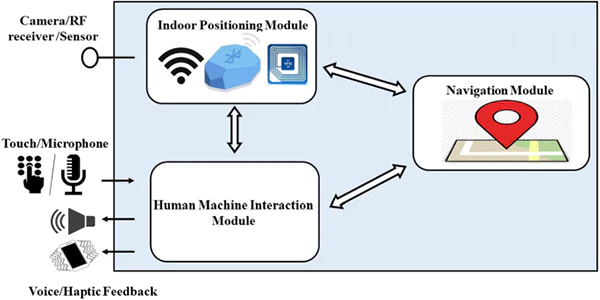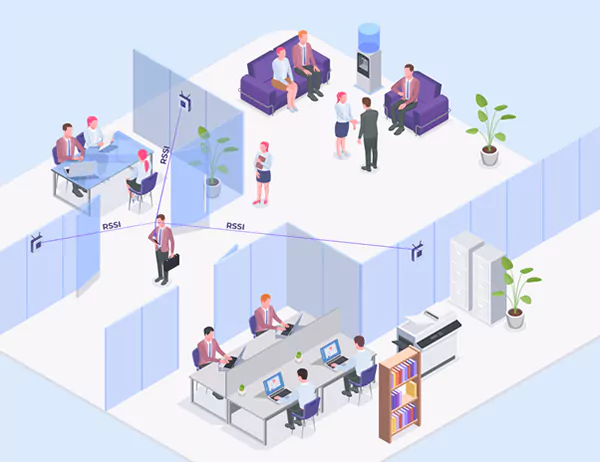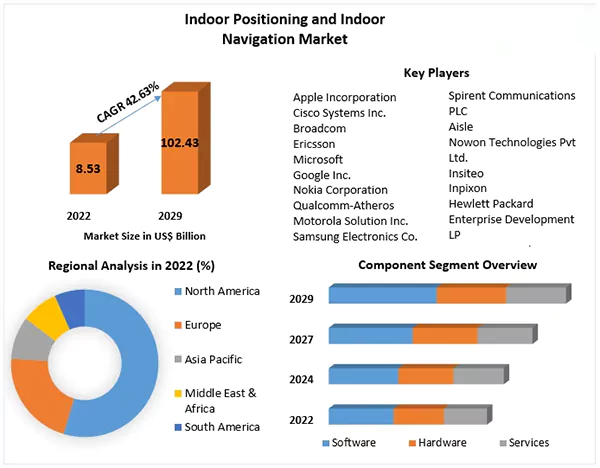Indoor navigation and wayfinding solutions are becoming increasingly important in industries that involve large and complex buildings or spaces. They fundamentally change the way people move in a given environment. From shopping centers to hospitals and airports, indoor wayfinding improves user experience, customer service, and therefore loyalty. In this article, we will explore the impact of this system on various industries and talk about new trends and prospects.
How Indoor Wayfinding Works Indoors
Indoor navigation and wayfinding facilitate navigation within spaces, enabling the creation of digital maps of buildings that pinpoint users’ locations and assist in route planning. Unlike conventional signs that offer limited directional instructions, this system provides valuable information about objects and optimizes paths to points of interest.
Two important components are needed to implement an indoor navigation system: software and specialized equipment known as tags, beacons, and gateways. Installed sensors emit periodic radio signals detected by receiving devices. Subsequently, these signals are processed on a server and relayed as refined location data to the user’s mobile application on their smartphone.
Navigation software can encompass various features, tailored to specific use cases and solutions. Common functionalities include:
- digital maps of premises
- real-time location tracking
- route configuration
- integration with other systems
- object identification

The software operates on a range of technologies, with Bluetooth Low Energy (Bluetooth® LE) or Wi-Fi being the most prevalent choices. These technologies boast energy efficiency and high location accuracy, enabling seamless real-time directions and personalized information delivery.
Indoor navigation surpasses traditional maps and signs by providing users with time-sensitive and constantly updated data that reflects real-time changes in the environment. If the layout has been modified or objects have been relocated, these alterations are reflected on the map.
it is user-friendly and presents a straightforward interface that is accessible to all. Information can be tailored to individual needs, accommodating users with mobility limitations. The platform meticulously constructs routes that consider elevators and ramps, ensuring accessibility for all. moreover, the technology supports accessibility and language functions, eliminating the need for technical support.
How Indoor Wayfinding Systems Are Used In Different Industries

The immense potential of navigation systems has made them increasingly prevalent across various industries. Utilizing this platform enhances the capabilities of enterprises, bolsters customer loyalty, and positively impacts profits. Its applications span from transportation hubs and shopping centers to museums and sports facilities.
Shopping centers
Large shopping centers often leave visitors perplexed, leading to hours of aimless wandering to locate desired stores, cafes, or service outlets. In these situations, navigation systems emerge as a lifesaver. Leveraging digital technologies, you can swiftly pinpoint your destination and avoid the stress induced by navigating complex structures. If a shopping center facilitates effortless navigation, it fosters customer satisfaction and encourages repeat visits.
By utilizing the capabilities of geolocation-based marketing, shopping center marketers can send personalized promotions, offers, and notifications to shoppers when they are near the center. This approach not only increases foot traffic but also allows for more targeted advertising, as marketers can tailor their messages based on factors such as demographics and shopping habits. Geolocation-based marketing enables shopping centers to deliver more relevant content to consumers, ultimately enhancing their shopping experience and driving sales.
Airports
Large airports consist of intricate networks of terminals and hallways. Amidst the hustle and anxiety of flight departures, passengers often face disorientation. Digital wayfinding minimizes the risk of missing a flight. It simplifies movement through the terminals and allows for rapid access to check-in counters, customs posts, restrooms, and other key points within the airport area.
Healthcare
Indoor wayfinding solutions play a vital role in hospitals, catering to both staff and visitors or patients. It facilitates:
- finding treatment rooms or wards in a short time;
- saving staff time that they spend explaining the route to visitors;
- getting directions to medical equipment that is urgently needed to save a life;
- providing effective evacuation routes in an emergency.
Offices
Modern business centers often occupy expansive structures spanning numerous floors and housing thousands of offices. Navigating these maze-like environments can be challenging. It translates into lost productivity spent finding the right destination. Implementing an indoor navigation system eliminates this hassle, allowing for seamless identification of offices and optimized route planning. The system also serves as an excellent navigation solution for visitors to the business center.
Museums
It guides museum visitors through their preferred galleries. The system simplifies navigation within the museum space, allowing visitors to locate interesting exhibits and receive relevant information through push notifications. This combination fosters loyalty to the museum and positions it as a forward-thinking cultural institution.
Sports facilities
Stadiums and other sports venues are not merely arenas for sports events but also house various amenities such as locker rooms, cafes, ticket booths, shops, and restrooms. Visitors can use digital maps on their smartphones to avoid getting lost amidst all of this. The system directs them to desired locations and provides valuable information about sports events in a format tailored to fans’ preferences. Statistics indicate that implementing this system can increase stadium revenues by approximately 20%.
Did You Know?
The indoor Positioning and Indoor Navigation Market was valued at US$ 8.53 Bn in 2022 and is expected to reach US$ 102.43 Bn by 2029, at a CAGR of 42.63% during the forecast period.

Trends In The Development Of Indoor Wayfinding Systems
Many experts envision a future dominated by indoor wayfinding. Global trends are emerging toward refining the platform and developing hardware-independent solutions for route planning. Employing phone sensors, the platform determines a person’s location and breaks down their path into simplified instructions (e.g. “turn right, walk 3 feet,” etc.). Others can follow the same route without the need for beacons or other sensors. Also, geomagnetic technologies utilize the smartphone’s built-in magnetic complex to determine a person’s position. Learn more about different types of Heating and Cooling Systems and their performance.
In conclusion, indoor navigation systems continue to evolve and gain traction within various industries. Their popularity stems from the wide range of benefits they offer to businesses. Integrating the system into infrastructure empowers companies to elevate customer service, significantly reduce costs, and optimize space utilization. Click here to know about top 7 Project Management Systems and how they work.







